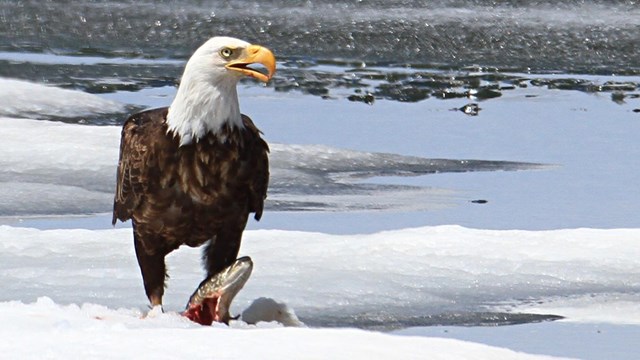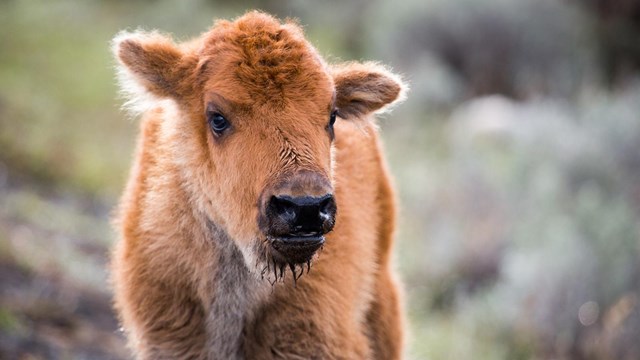
NPS / Neal Herbert Golden eagles (Aquila chrysaetos) are large, long-lived raptors that feed on grouse, small mammals (e.g., rabbits, marmots, and ground squirrels), and carrion. Across the western USA, and in Wyoming in particular, there are growing concerns about the status of golden eagle populations due to broad-scale energy development (wind, gas) and increasing human activity. To better understand the current population status and the drivers of population trends across the ecosystem, park biologists began focused study of golden eagles in Yellowstone in 2011. Surveys have located 30 golden eagles territories inside the park. Twenty-two of the 30 territories are located in Yellowstone’s Northern Range, the resulting density (one territory per 45.5 km2) is relatively high. Likewise, territory occupancy rates from 2011 to 2023 have been consistently high (100%). In contrast, low average productivity at these nests (0.32 young/occupied territory) is driven by both infrequent nesting attempts and low nest success. For example, in 2023, researchers monitored 23 occupied territories through the end of the breeding season; 12 occupied nests were detected and six were successful in fledging seven young. With such low productivity, the Yellowstone golden eagle population may be dependent on outside immigration, although much about the status of the park’s golden eagle population remains unknown. In other studies, reproductive failure of eagles and other raptors has been correlated with weather (e.g., high failure in high precipitation years), often interacting with food availability. Research in northern Yellowstone has found that prolonged precipitation, high snow pack, and severe weather events during winter and early spring have a negative effect on successfully fledging young. OutlookIn response to broad concerns about golden eagle populations, Wyoming has initiated a golden eagle working group and the US Fish and Wildlife Service has instituted a western US study modeling eagle habitat suitability, human development risks, lead exposure, and large-scale movements. Better under-standing of the ecology of Yellowstone National Park eagles requires study of their food habits, toxicology, survival, and movement both within and outside the park. In recent years, extensive data relating to these key topics have been collected in two study areas flanking the park to the north and east and complimentary research within the park is ongoing. Resources1940. Bald Eagle Protection Act of 1940 In 16 US Code 668- 668d, 54 Stat. 250. Baril, L.M., D.W. Smith, T. Drummer, and T.M. Koel. 2013. Implications of cutthroat trout declines for breeding ospreys and bald eagles at Yellowstone Lake. Journal of Raptor Research 47(3): 234–245. Buehler, D.A. Bald Eagle. The Birds of North America Online. Crandall, R.H. 2013. Identifying environmental factors influencing golden eagle presence and reproductive success. Thesis. University of Montana, Missoula, Montana, USA. Haines, D.B. 2020. Golden Eagle Resource Selection and Environmental Drivers of Reproduction in the Northern Range of Yellowstone National Park. Thesis. University of Montana, Missoula, Montana, USA. Harmata, A. 1994. Yellowstone’s bald eagles: Is the park a “black hole” for the national symbol? Yellowstone Science 2. Harmata, A.R. and B. Oakleaf. 1992. Bald eagles in the greater Yellowstone ecosystem: an ecological study with emphasis on the Snake River, Wyoming, Edited by Wyoming Game and Fish Department. Cheyenne, WY. Harmata, A.R., G.J. Montopoli, B. Oakleaf, P.J. Harmata, and M. Restani. 1999. Movements and survival of bald eagles banded in the Greater Yellowstone Ecosystem. Journal of Wildlife Management 63(3):781–793. Preston, C.R., R.E. Jones, N.S. Horton. 2017. Golden Eagle Diet Breadth and Reproduction in Relation to Fluctuations in Primary Prey Abundance in Wyoming’s Bighorn Basin. Journal of Raptor Research 51(3): 334-346 Swenson, J.E. 1975. Ecology of the bald eagle and osprey in Yellowstone National Park. M.S. Bozeman, MT: Montana State University. Steenhof, K., M.N. Kochert, T.L. McDonald. 1997. Interactive Effects of Prey and Weather on Golden Eagle Reproduction. Journal of Animal Ecology 66:350-362 
Bald Eagle
Bald eagles can be seen along Yellowstone's many rivers and lakes. 
Wildlife
Learn about the park's abundant and diverse species—67 mammals, 330 birds, 16 fish, 5 amphibians, and 6 reptiles. |
Last updated: April 18, 2025
